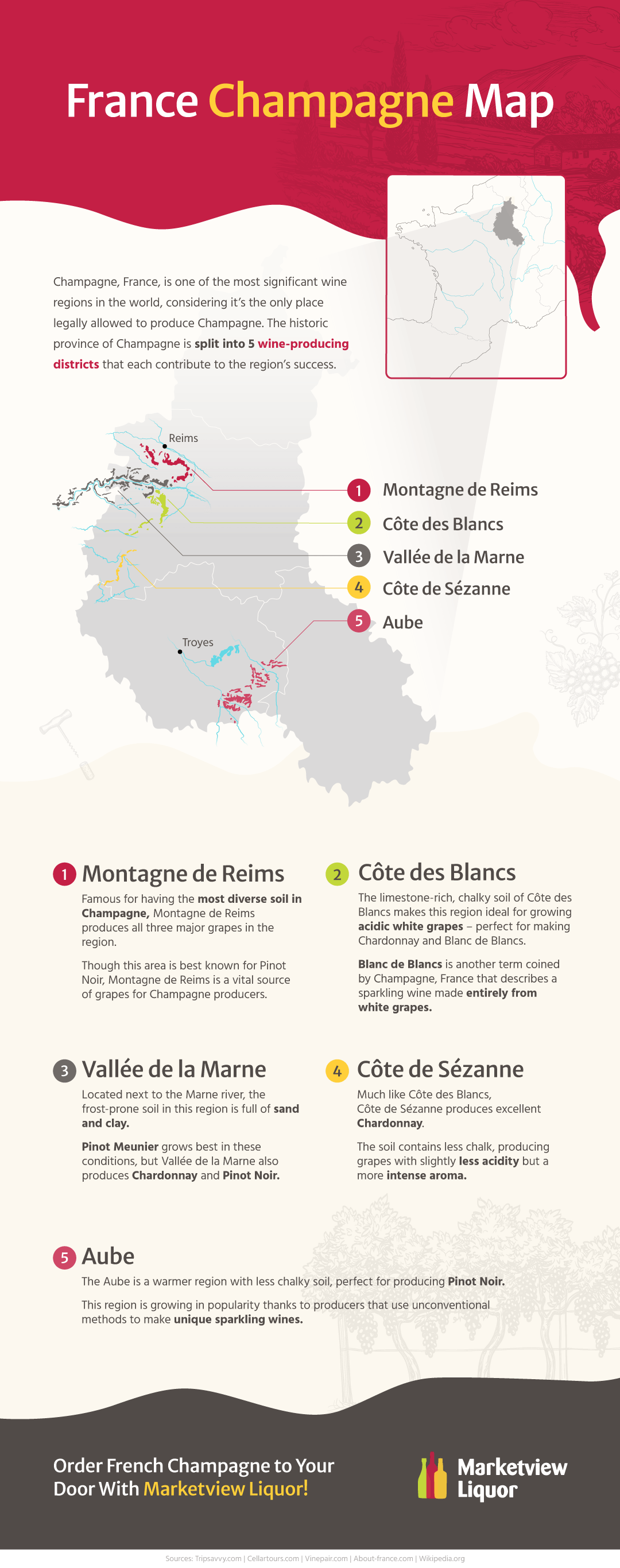Residing just East of Paris toward France’s northern tip is a quaint and calm region that significantly impacts the world. The region is Champagne, one of the world’s leading wine producers.
People worldwide know the Champagne region for the sparkling wine that shares its name. Champagne is the only region in the world legally permitted to produce this beloved beverage, and local winemakers do so to global acclaim. The region comprises five distinct districts, each known to make a unique variety of Champagne.
Check out our map of the Champagne region and continue reading to discover the fascinating traits that characterize each district and the varieties they produce.

The 5 Wine-Producing Districts in France
Champagne is a cool region with lush forests and mineral-rich soil. The geography and climate position Champagne to grow acidic grapes that lend themselves to bubbly drinks. Each of Champage’s five districts offers a unique expression of the region’s conditions, resulting in a distinct variation of its namesake beverage. Here is an overview of Champage’s wine-producing districts.
Montagne de Reims
Montagne de Reims is in the northeastern portion of Champagne. This district has the most diverse range of soil compared to the other four. As a result, Montagne de Reims produces the three major grape varieties that grow in Champagne — Chardonnay, Pinot Noir and Pinot Meunier. Of these three varieties, Montagne de Reims is most renowned for its Pinot Noir. Most of Champagne’s Pinot Noir grapes come from the Montagne de Reims district.
Côte des Blancs
Côte des Blancs is in the center of the Champagne region. This location features chalky soil due to the prominence of limestone. The chalky soil is ideal for cultivating the acidic white grapes used to produce Blanc de Blancs and Chardonnay.
Vallée de la Marne
Vallée de la Marne is a district along the Marne river. Its riverside positioning fills the district’s soil with sand and clay, easily accumulating frost during Champagne’s brisk mornings. These conditions help growers in Vallée de la Marne produce exceptional grapes for Pinot Meunier. However, the district is also a prominent producer of Pinot Noir and Chardonnay.
Côte de Sézanne
Côte de Sézanne is a district in the southern corner of Champagne with traits similar to Côte des Blancs. However, the soil is slightly less chalky, meaning the grapes it produces are lower in acidity yet more aromatic. Côte de Sézanne produces excellent Chardonnay, though it sees less mainstream acclaim than its counterpart to the northeast.
Aube
Aube is a satellite district that resides outside the primary Champagne region. This district is deeper south than the rest of Champagne, giving it a warmer climate with less of the chalky soil that the other four feature. Aube’s conditions and the innovative vinification methods its growers employ produce fine Pinot Noir grapes. As a result, Aube boasts an upward trend in popularity.
Order French Champagne to Your Door With Marketview Liquor!
You can experience the splendor of authentic French Champagne by ordering from Marketview Liquor. We carry a wide selection of Champagne and ship to over 40 states. To discover the varieties we have to offer, please browse our Champagne selection and place your order online today!
